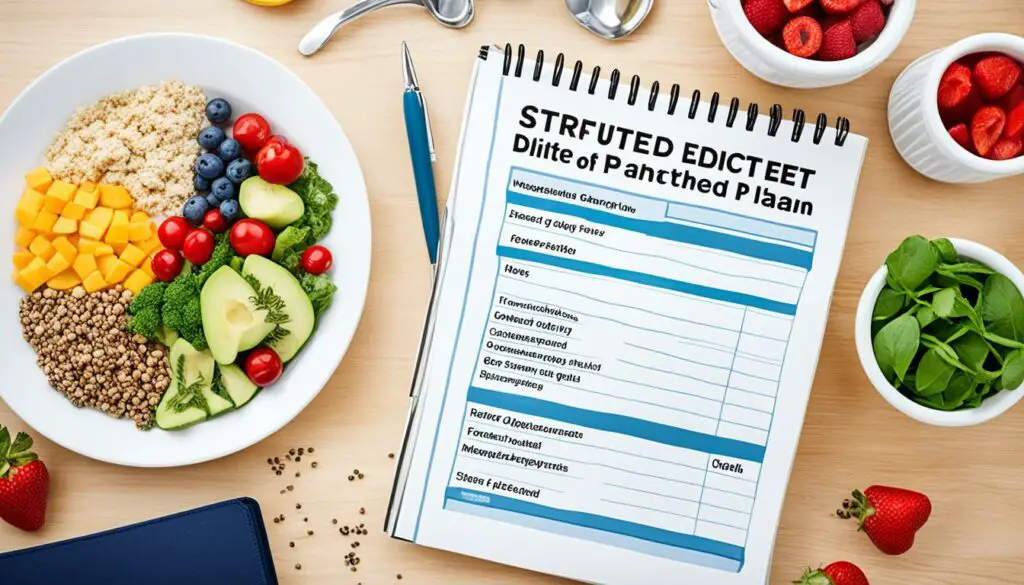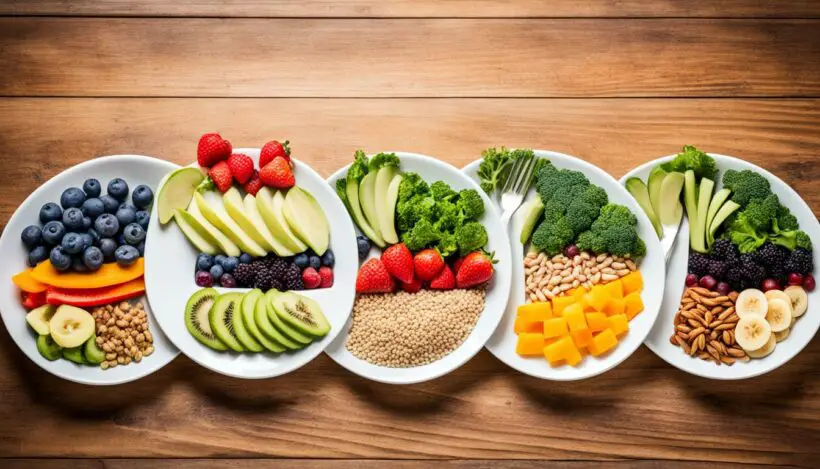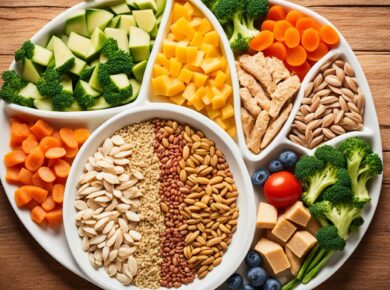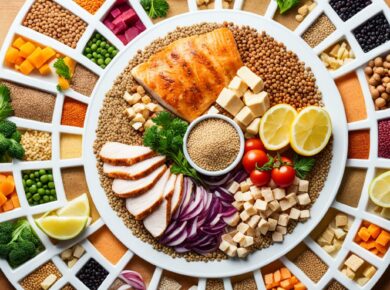Achieving meaningful and long-lasting weight loss requires a thoughtful eating plan. Your body needs the right balance of nutrition and calories for sustained energy through workouts and daily activities. Maintaining that balance is the key to losing fat and keeping it off over time. A successful structured diet plan for weight loss combines the vitamins and minerals your body needs to build muscle and maintain energy in one convenient and delicious menu. Follow these steps to design a diet plan for weight loss that’s specifically structured to support your lifestyle, goals, and habits.
In this article, we’ll explore how to create a customized diet program that suits your needs and preferences. Say goodbye to generic meal plans and hello to a healthy meal plan that is tailored to you!
Step One: Avoid Calorie Counting Diet Plans
When it comes to designing a diet plan, many people are familiar with the concept of counting calories. However, the strict nature of calorie counting can be both challenging and restrictive. Daily calorie goals can be difficult to maintain, as different foods have varying calorie content. Additionally, constantly tracking and counting every calorie can take the joy out of social situations and even lead to undereating.
Instead of solely focusing on calorie counting, it is recommended to develop a diet plan that covers your nutritional needs for maintaining a healthy lifestyle. By shifting the focus from counting calories to balancing essential nutrients, such as protein, carbs, fats, vitamins, and minerals, you can create a more flexible and sustainable approach to your diet plan.
It’s important to remember that a calorie is not just a calorie. The nutritional value of the foods you consume plays a crucial role in supporting your overall health and well-being. Rather than obsessing over daily calorie goals, prioritize the quality of the foods you eat to ensure you’re obtaining the necessary nutrients for optimal energy and nourishment.
To avoid the pitfalls and limitations of calorie counting, focus on creating a diet plan that encompasses a wide variety of nutrient-rich foods. Emphasize whole foods, such as fruits, vegetables, lean proteins, whole grains, and healthy fats, to provide your body with the fuel it needs to thrive.
By adopting this approach, you can enjoy the benefits of a well-rounded diet plan without the stress and constraints of calorie counting. Remember, it’s all about nourishing your body with the right nutrients and finding a sustainable eating pattern that works for you.
Stay Flexible with Your Nutrition
One of the significant advantages of avoiding calorie counting is the ability to incorporate occasional indulgences. Building a cheat day into your diet plan allows for flexibility and enjoyment without derailing your progress. However, it’s important to approach cheat days mindfully and practice moderation. By savoring your favorite treats in moderation, you can satisfy cravings while maintaining a healthy overall eating pattern.
When it comes to designing a successful diet plan, remember: it’s not just about the numbers. Focus on nourishing your body with nutrient-dense foods, finding a balance that works for you, and keeping sustainability at the forefront.
Step Two: Calculate Your Macros
Dieting is not just about how much you eat but also about the macronutrients your body needs for muscle growth, fat burning, and energy. Balancing carbohydrates, fats, and proteins can optimize weight loss efforts.
To calculate your macros, you’ll need to determine the ideal ratio of macronutrients based on your unique needs and goals. This can be done using an online calculator specifically designed for this purpose. These calculators take into account factors such as your weight, activity level, and desired calorie intake to provide you with a personalized breakdown of the macronutrients you should aim for.
For example, if you’re following a low-carb diet, you may need to have higher protein and fat intake. On the other hand, if you’re focusing on building muscle, you may need a higher carbohydrate and protein intake.
By knowing exactly how many grams of carbohydrates, fats, and proteins you should be consuming each day, you can fine-tune your diet plan and ensure you’re getting the right balance of nutrients. This not only supports your weight loss goals but also helps you maintain optimal energy levels and overall well-being.
Remember, the key is to customize your macronutrient intake based on your specific needs and goals. Using an online calculator can simplify the calculations and provide you with the guidance you need to create a diet plan that sets you up for success.
Next, we’ll discuss how to find foods that fit your dietary preferences and nutritional needs in Section 4.
Step Three: Find Foods That Fit
When designing a personalized diet plan, it is crucial to find foods that fit your dietary preferences and nutritional needs. A healthy meal plan should incorporate a variety of fruits, vegetables, grains, and other ingredients to ensure a well-rounded and balanced approach to nutrition.
Experimentation is key when it comes to finding foods that align with your dietary goals. Don’t be afraid to try new options and flavors as you navigate your weight loss journey. By exploring different food choices, you can discover a wide range of options that not only cater to your taste buds but also provide the necessary macronutrients for a well-rounded meal.
Pay attention to the macronutrient content of each item you include in your diet plan. Understanding the macronutrient composition of the foods you consume can help ensure you’re achieving a balanced intake of carbohydrates, proteins, and fats. This knowledge will empower you to create meals that satisfy your hunger, support your fitness goals, and keep you energized throughout the day.
Remember, variety is key. Incorporating a diverse range of foods into your diet not only offers a wider array of nutrients but also prevents meal boredom. This variety will help you stay motivated and committed to your weight loss journey.
By finding foods that fit your dietary preferences and nutritional needs, you can create a sustainable and enjoyable diet plan that supports your weight loss efforts. So go ahead, explore the grocery store aisles, experiment with new recipes, and embrace the delicious possibilities that await you on your journey to a healthier lifestyle.
Step Four: Stock Up on Recipes
Building a collection of recipes is essential for a successful diet plan. Having a diverse selection of recipes prevents boredom and helps you stay motivated. Whether you prefer quick and easy meals or gourmet dishes, having a variety of recipes at your fingertips ensures that you never run out of delicious options to enjoy.
When stocking up on recipes, consider your preferences and health goals. Look for recipes that align with your dietary needs, whether it’s low-carb, vegetarian, or gluten-free. Aim for a balance of flavors, nutrients, and food groups to ensure a well-rounded diet.
An online recipe book can be a valuable tool in finding and storing recipes. With just a few clicks, you can access a vast selection of recipes from trusted sources. These online resources often provide detailed preparation instructions, ingredient lists, and even nutrition facts, making it easier to plan and track your meals.
So, take the time to stock up on recipes that excite you and fit into your diet plan. Having a repertoire of tasty and nutritious meals will keep you engaged and motivated on your weight loss journey.
Having a diverse selection of recipes prevents boredom and helps you stay motivated.
Step Five: Set an Eating Schedule
When it comes to weight loss, the timing and frequency of your meals can make a significant impact. Designing an effective eating schedule can help optimize your metabolic cycles and regulate blood sugar levels, ultimately supporting your weight management goals. Here are some tips to help you create a healthy and balanced meal timing routine:
- Eat a High-Protein Breakfast: Starting your day with a protein-rich meal can kickstart your metabolism and help you feel fuller for longer. Incorporate foods like eggs, Greek yogurt, or a protein smoothie into your morning routine.
- Space Out Your Meals and Snacks: Instead of consuming large meals or indulging in constant snacking, aim to have regular, well-balanced meals and snacks throughout the day. This approach can help stabilize your energy levels and prevent excessive hunger.
- Avoid Late-Night Snacking: Late-night snacking can disrupt your sleep and lead to unnecessary calorie consumption. Try to finish your last meal or snack at least two hours before bedtime to give your body ample time to digest.
By experimenting with different meal timing strategies and finding what works best for you, you can align your eating schedule with your body’s natural rhythms and support your weight management efforts. Properly timed meals can help regulate your metabolism, control hunger, and maintain stable blood sugar levels.
Step Six: Track, Analyze, and Adjust
Keeping a food diary is a valuable tool when it comes to achieving your weight loss goals. By recording your eating habits, you can track and analyze your nutritional intake, making adjustments to your diet plan as needed. A food diary allows you to gain insight into your eating patterns and identify any areas that may need improvement.
When starting your food diary, make sure to record what you eat, portion sizes, and the time of day. Additionally, note any emotions or situations that may have influenced your food choices. By keeping a detailed record, you can identify any triggers or patterns that may be hindering your progress.
Analyzing your food diary will help you identify any areas where adjustments are necessary. Look for patterns and trends that may be impacting your weight loss journey. For example, you may notice that you tend to snack more in the evenings or that certain foods make you feel bloated or tired. Understanding these patterns can help you make informed decisions about your diet.
Once you have analyzed your food diary, it’s time to make adjustments to your diet plan. This might involve modifying portion sizes, swapping out unhealthy snacks for healthier alternatives, or experimenting with different meal timings. The goal is to create a personalized plan that fits your lifestyle and supports your weight loss journey.
Remember, the key to successful weight loss is consistency and adaptability. Use your food diary to continuously track, analyze, and adjust your eating habits as you progress towards your goals. By staying proactive and making tweaks along the way, you can create a personalized plan that maximizes your chances of success.
Optional Step: Find a Professional Diet Plan for Weight Loss
For additional guidance and support, consider seeking assistance from professionals who can create a medically accurate diet plan tailored to your specific needs. Experts, like the team at Med-Fit, can help you design a customized weight loss journey that aligns with your goals and promotes long-term success.
Expert Guidance for Personalized Weight Loss Journey
Embarking on a weight loss journey is a personal endeavor, and having professional guidance can make all the difference. A professional diet plan ensures that you receive the right nutrition and support, taking into account your unique circumstances and preferences.
- Medically Accurate Plan: The team at Med-Fit understands the science behind weight loss and designing a plan that is safe and effective for your body. Their medically accurate approach ensures that your diet plan supports your overall health and well-being.
- Personalized Approach: Everyone’s weight loss journey is different, and a personalized plan takes into account your specific needs, such as food preferences, lifestyle, and any underlying health conditions. This tailored approach increases the chances of achieving sustainable results.
- Expert Guidance: With Med-Fit, you’ll have access to trained professionals who have extensive knowledge and experience in developing personalized diet plans. They can guide you through the process, providing support, motivation, and accountability.
Choosing a professional diet plan can provide you with the tools and resources you need for a successful weight loss journey. Consider partnering with Med-Fit or a similar trusted provider to ensure you receive the guidance necessary to reach your goals.
Designing a Customized Weight Loss Plan
When it comes to weight loss, a one-size-fits-all approach simply doesn’t cut it. That’s why customized diet plans have become increasingly popular. By taking into account your personalized needs, individual eating styles, family and work schedules, and exercise preferences, these tailored plans offer a more sustainable and effective way to shed those extra pounds.
With a customized diet plan, you can say goodbye to the frustration of following generic programs that don’t align with your unique lifestyle. Instead, you’ll have a plan that works specifically for you, taking into consideration your busy schedule, favorite foods, and preferred exercise routines.
By incorporating your individual eating styles into the plan, you can enjoy meals that you genuinely look forward to. Whether you prefer vegetarian, gluten-free, or dairy-free options, your customized diet plan can be designed to accommodate these preferences, making it easier to stick to your weight loss goals.
Family and work schedules can often make it challenging to maintain a healthy diet. However, with a customized plan, you can create a strategy that works around your commitments. Whether it’s preparing meals in advance, finding quick and nutritious recipes for busy nights, or incorporating family-friendly options, you have the flexibility to design a plan that suits your lifestyle.
And let’s not forget about exercise preferences. Some people thrive in the gym, while others prefer outdoor activities or home workouts. Whichever category you fall into, your customized plan can be tailored to include exercises that you enjoy and find motivating. This way, you’ll be more likely to stick to your fitness routine and maximize your weight loss efforts.
Remember, the key to successful weight loss is finding a plan that is designed specifically for you. By considering your personalized needs, individual eating styles, family and work schedules, and exercise preferences, a customized diet plan can provide the tailored approach you need to achieve long-lasting results.
Creating Your Own Diet Plan: Self-Reflection and Questions to Consider
Before embarking on the journey to create your own personalized diet plan, take a moment for self-reflection. It’s important to consider various factors that contribute to weight loss success so that you can tailor your approach to meet your unique needs and preferences.
1. Eating Schedule
Firstly, think about your eating schedule. Are you someone who prefers three square meals a day or smaller, more frequent meals? Do you have a busy lifestyle that requires quick and convenient meals? Take into account your daily routine and find an eating schedule that suits you best.
2. Food Preferences
Consider your food preferences when designing your diet plan. Ask yourself questions like: What are your favorite healthy foods? Do you have any specific dietary restrictions or allergies? By incorporating foods that you enjoy, you’ll be more likely to stick to your plan and find joy in your meals.
3. Support System
Think about the support system you have in place. Do you have a friend or family member who can join you on this journey and provide accountability? Are there any online communities or forums that can offer guidance and motivation? Surrounding yourself with positive influences can greatly increase your chances of success.
4. Exercise Routine
An exercise routine is an important aspect of any weight loss plan. Consider the types of physical activities you enjoy and can realistically incorporate into your daily life. Whether it’s walking, yoga, weightlifting, or dancing, finding an exercise routine that matches your interests will make it easier to stay consistent.
By answering these questions and engaging in self-reflection, you can design a diet plan that is personalized to your unique needs and preferences. Remember, it’s all about finding a sustainable approach that aligns with your lifestyle.

Continue reading to learn how to structure your personalized diet plan and make it a successful part of your weight loss journey.
Conclusion
In conclusion, creating a personalized diet plan that caters to your individual needs and preferences is crucial for achieving successful and sustainable weight loss. By following the steps outlined in this article and taking into account personal factors and self-reflection, you can design a diet plan that works best for you.
Remember, the key is to find a balanced and enjoyable approach to nutrition and wellness. Ensure that your diet plan includes a variety of nutritious foods and is tailored to meet your specific goals and lifestyle. By doing so, you can embark on a weight loss journey that is both effective and sustainable in the long term.
By taking a personalized approach to your diet and considering factors such as macronutrient intake, meal timing, and individual food preferences, you can optimize your weight loss efforts and increase the likelihood of long-term success. Embrace this sustainable approach to weight management, and you’ll be well on your way to achieving your desired health and wellness goals.






